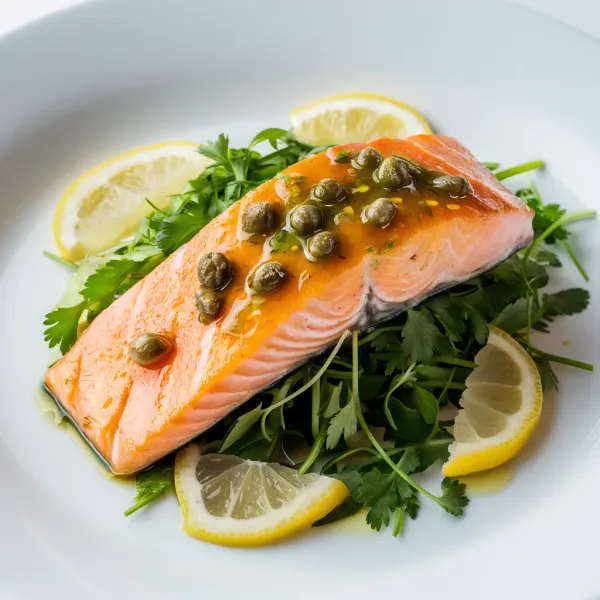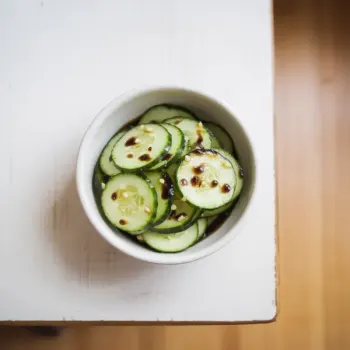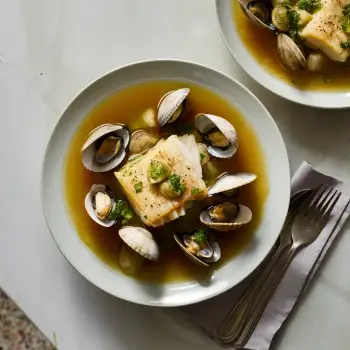
 30 minutes
30 minutesA delicate and flavorful poached salmon served with a vibrant caper vinaigrette.


Lemons, sliced
each
Flat Leaf Parsley, chopped
tablespoons
Tarragon, chopped
tablespoons
Shallots, minced
cups
cups
cups
Salmon Fillet, skinless
0 lb
Capers, rinsed and chopped
tablespoons
tablespoons
tablespoons
to taste
to taste
1. Prepare the Lemon Base
Start by ensuring your salmon fillet is skinless to allow for even cooking and maximum flavor absorption. If your fillet still has skin, carefully remove it with a knife. Next, slice the lemons into thin rounds and arrange them in a single layer at the bottom of a 12-inch skillet.
2. Create the Poaching Liquid
Add the stems from the parsley and tarragon, the minced shallot, the white wine, and water to the skillet. Bring this mixture to a gentle simmer over medium heat.
3. Poach the Salmon
While the liquid is warming up, season the salmon generously with salt and pepper to enhance its natural flavors. Once the poaching liquid is simmering, place the salmon fillet on top of the lemon slices. Cover the skillet with a lid and let the salmon poach gently until it reaches your desired doneness.
4. Prepare the Vinaigrette
When the salmon is cooked, carefully transfer it to a plate and cover it with foil to keep it warm. Strain the poaching liquid through a fine-mesh strainer and return the clear liquid to the skillet. Stir in the chopped capers, extra-virgin olive oil, honey, and the chopped parsley and tarragon. Adjust the seasoning of the sauce with salt and pepper to taste.
5. Serve
Serve the caper vinaigrette alongside the poached salmon fillets, allowing the tangy and herbaceous sauce to complement the delicate, moist salmon.
Include olives and sun-dried tomatoes in the vinaigrette for a Mediterranean twist. You could also add a splash of ouzo or Pernod to the poaching liquid for an anise flavor.
Replace the lemon with other citrus fruits such as orange, grapefruit, or lime for a different acidic note. For example, orange-herb poached salmon can offer a sweeter, more mellow citrus flavor.
Incorporate Asian ingredients such as ginger, lemongrass, and soy sauce into the poaching liquid. For the vinaigrette, use rice vinegar and a touch of sesame oil, and garnish with sesame seeds.
Gently poach tofu in a mix of white wine, vegetable broth, bay leaves, and peppercorns. Prepare a vinaigrette with olive oil, white wine vinegar, Dijon mustard, and a mix of fresh herbs like tarragon and chives.
Swap out the herbs used in poaching and in the vinaigrette. Try dill or tarragon for a French twist, or cilantro and flat-leaf parsley for a more Latin-inspired version.
Start with the freshest, sustainably sourced salmon. Wild-caught often offers superior flavor and texture. Opt for center-cut fillets for even cooking and presentation.
Flavor the liquid with fresh herbs, lemons, and aromatics like onions or shallots. Ensure it simmers gently before adding the salmon to protect its delicate flesh.
Use a meat thermometer to check for doneness . 120°F for medium-rare, 125°F for medium. Remove the salmon slightly under the target temperature to account for carryover cooking.
Achieve a balanced emulsion and rinse capers for a milder taste if preferred. Use high-quality ingredients for the best flavor.
Let the salmon rest after poaching to redistribute the juices, ensuring a moist and tender result.




Comments (0)